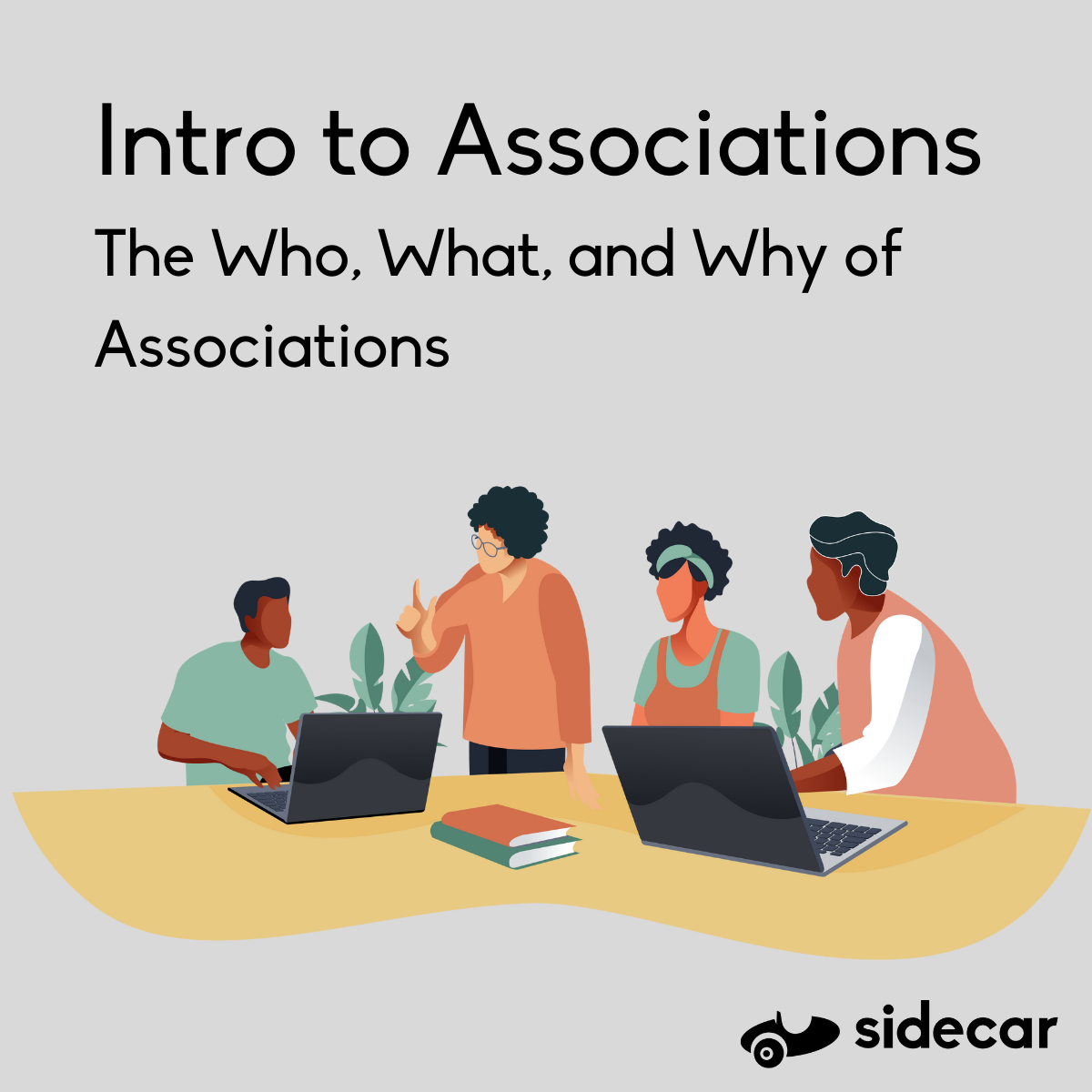In an association, you likely have staff and an executive director or CEO who handle day-to-day operations. So what does the board of directors do? Put simply, they control the overarching strategy and direction of the association. But who are they, how were they chosen and what does their role actually entail?
Here is everything you need to know about a board of directors.
What Is a Board of Directors?
In simple terms, the board of directors is the governing body for an association or nonprofit. They’re responsible for advancing the organization's mission while also adhering to legal and fiduciary responsibilities.
According to the National Council of Nonprofits, “Just as for any corporation, the board of directors of a nonprofit has three primary legal duties known as the ‘duty of care,’ ‘duty of loyalty,’ and ‘duty of obedience.’”
- Duty of Care – Creating an operating environment leveraging all assets, including staff and finances.
- Duty of Loyalty – Ensuring all decisions move the organization forward and adhere to the overall mission and vision. Additionally, avoiding any conflicts of interest or behaviors detrimental to the organization.
- Duty of Obedience – Keep the organization in good standing with applicable laws or regulations and protect it from costly legal or financial consequences.
Governance vs. Management
One of the key differences between an association’s board of directors and its staff is based on their core responsibilities. The board is responsible for handling the “big picture” strategy for the organization – what it needs to do to grow and advance the overall mission and success of the association.
Staff handle day-to-day operations and are responsible for executing the mission and strategies the board has set forth. Of course, for this relationship to work and for associations to remain successful, boards need to be dynamic, involved and understanding, allowing everyone to adjust to the changing needs of members and the industry as a whole.
Board of Director Roles & Responsibilities
While board structures can change depending on location – for example, Florida requires a board of directors to have a minimum of three members – most associations will have a few consistent roles.
- President or Board Chair – The board’s leader, responsible for presiding over meetings, establishing agendas and goals, appointing committees and holding other board members accountable. They are also the primary contact between the board and association CEO or executive director.
- Vice President or Vice Chair – The second in command for the board of directors. Responsible for handling special assignments, serving on committees and being available to assume the president's responsibilities should they be absent.
- Treasurer – Responsible for overseeing the financials of the association. Not only do they track expenses and disbursements, but they’re also responsible for preparing and reviewing the annual budget.
- Secretary – Responsible for distributing agendas and pertinent documents at meetings, scheduling board meetings and holding members accountable for their tasks. They’re also particularly important during board meetings as they’re often responsible for meeting minutes.
- Members – The biggest group within a board of directors are the members. While they may not have leadership roles as outlined above, they’re still an essential part of the strategy and governance decisions, generally with voting power.
What Do Board Members Do?
What other responsibilities does the board of directors have beyond running and attending meetings? While board member job duties depend on the association, responsibilities can include:
- Plan the overall growth strategy for the association.
- Set goals and objectives for the association to accomplish.
- Manage financial projections and allocate funds to different programs.
- Create committees and assign tasks to achieve organizational goals.
- Act as an ambassador for the organization.
- Recruit and mentor new board members.
Another massive responsibility of the board of directors is selecting the CEO or executive director. This role is not only key for the growth of an organization, but with duties over hiring and executing the goals and mission set by the board, they can have a significant impact on the future.
Because of this, the board of directors must be entrusted with assessing the association's needs, interviewing candidates and setting the compensation package while also handling annual evaluations to ensure they’re the right fit.

Intro to Associations
In an association, you likely have staff and an executive director or CEO who handle day-to-day operations. So what does the board of directors do? Put simply, they control the...
Free Course
Board and Committee Dynamics
In an article for MissionBox, Leigh McKinney explains that “the board of directors accomplishes much of its work through committees, which undertake work delegated by the board, make recommendations to the board for discussion and action, and enhance board productivity.”
Not only does this help streamline work, but committees often handle the day-to-day tasks for nonprofits and associations with limited staff. The board of directors is responsible for establishing these committees and also often take a role within them.
These committees can handle finances, marketing, member engagement, event planning and editorial or content direction. They aim to tackle essential initiatives and then report to the board, making the organization's final decision.
How Are Board of Director Members Selected?
There is no debate that the board of directors has a considerable impact on the future and success of an organization, which is why choosing the right members is vital. For nonprofits, the initial board of directors is appointed when the organization is founded. However, from there, finding and choosing board members usually happens in a few different ways.
They’re either elected or appointed by existing board members, a nominating committee, or the association members themselves.
What Makes a Good Board of Directors Member?
- They Understand the Commitment – The most crucial part of choosing board members is finding someone committed. Their impact on your organization is enormous, so missing meetings and failing to complete projects can have a lasting effect.
- They’re Open To Learning – While most associations opt for board members with a good amount of expertise, that doesn’t mean they won’t be learning. Not only do they need to learn about your organization, but they also need to understand and learn about the needs of their members to serve them best.
- They Believe In the Mission – For purpose-driven organizations, the mission is everything. Your board member selections should be invested in the organization's vision and goals and have a vested interest in seeing it grow.
- They Offer a New Perspective – The importance of diversity cannot be overstated. Because the board of directors impacts the lives of your association members and staff, you need to trust that they have their best interests in mind. Having board members with diverse backgrounds, experiences and ways of thinking can help create a more equitable and inclusive organization.
Creating a Strategy for Success with your Association Board
While finding invested and qualified board members can help your association run smoothly, setting clear expectations is just as important. The board of directors plays a pivotal role in big picture decisions for your organization, so setting them up for success and creating a clear line of communication is key.
So how do you create a strong dynamic?
- Understand the needs of your association – The board of directors is often selected because of the experience and expertise they bring to the table. Because of this, knowing the organization's needs can help refine what members are needed. For example, if your association struggles with marketing, finding a board member with an extensive background in that industry can help you fix those issues in your strategy.
- Meet with them often – While the board of directors is focused on the organization's overarching strategy, they still need to understand the issues and needs of the organization. There should be an open dialog between the board and the CEO, which is where this information is relayed. By focusing on open communication, staff can impact board agendas and strategies.
- Have a plan for term ends – Finding board members can already difficult because of time commitments and availability. The best way to avoid downtime or slowdown in strategy is to have new members in mind before the term ends. Organizations should know the term limits, allowing them to recruit new members with plenty of time to spare.
- Learn from them before they go – When a board member exits, the focus will often shift to finding their replacement. However, these exiting members can also be an invaluable resource. By conducting board member exit interviews, you can gain insights into what is and isn’t working in terms of board governance, what professional development may be needed to excel as a board member and what plans should be a top priority, among other things.
8 Questions for Potential Board of Directors Members
Finding members for the board of directors is often challenging for associations. While having clear and detailed descriptions on your organizational site can help, there are some questions that potential board members may still have.
1. How much responsibility is this going to be, and what's expected of me?
Joining the board of directors is a huge responsibility and commitment. As a board member, you’re responsible for establishing the strategy for the entire organization – which means your decisions can have a lasting impact.
As a board member, you’re expected to attend meetings, create and lead committees that handle day-to-day operations for the organization, and help find the organization's CEO.
2. What does a board meeting look like, and how often do we meet?
At a bare minimum, a board of directors should meet once a year. However, depending on the needs of your organization and the rules outlined in the bylaws, they’ll meet more often than that. These meetings might be in-person, or they might be virtual (or a mix of both!).
During a board meeting, members will discuss strategy, establish KPIs and discuss any concerns or problems that need to be addressed. This is also why board meetings should happen more often – to better assess growth and whether or not those metrics are being met.
3. Why should you want to be on a board?
Serving on the board of directors for an association is a huge accomplishment. But how do you know if it’s the right thing for you? While there are plenty of reasons, they generally fall into two categories:
- Personal Growth – The most significant benefit to joining a board is professional growth. Alyssa Gelbard says it will “provide you with an incredible opportunity to meet influential, intelligent and well-connected people.” Additionally, it hones your leadership skills, builds your personal brand and increases your visibility in the space, leading to more opportunities.
- Organizational Growth – If you’ve been selected to serve on a board, you’re likely seen as aligning with the organization's values and mission. Joining the board can be a rewarding experience that allows you to give back and help make an impact.
There is no right or wrong answer – you just have to determine if those benefits and growth opportunities are something that aligns with your goals and values and work with the time commitment required.
4. Do board of directors get paid?
While it is not technically illegal, historically, board of director members are not paid as these are voluntary roles.
They may get reimbursed for any travel expenses, such as traveling to and from board meetings, but payment beyond those expenses is not common.
Why?
For starters, because the board of directors handles an organization's finances, it can often be seen as a conflict of interest. Similarly, paying the board could discourage volunteering and even donations to the board. Also, should the board of directors be compensated, they would also lose some of the legal protection afforded volunteers.
However, being on a board of directors is a sizable commitment, and some organizations do compensate board members. Not only does it help establish a sense of professionalism and qualification for the role, but it can also help promote economic diversity and provide opportunities for those who may have been unable to provide their service previously.
5. Can a paid employee be on the board of directors?
Simply put, not really. While it isn’t expressly illegal – although some state regulations may prohibit it – it’s often seen as a conflict of interest. For example, how can someone take an impartial role in the organization's management when it directly impacts them?
Most board of directors have at least one staff member on the board – generally the CEO or executive director – but they will likely not have voting rights because the board is responsible for hiring and compensation for that role, and once again, that’s a conflict of interest.
6. How much time does it take to be a part of a board?
There are no hard and fast rules regarding the time it takes to join a board of directors. Different associations have different needs, and if your expertise and background are a fit for a board vacancy, you may be elected.
However, studies have shown that the average age of board members is 40, with 70% of board chairs being non-Latinx white. This lack of diversity can often create barriers to a board seat that have nothing to do with experience and everything to do with demographics.
One of the first ways you can start a path towards a board seat is to volunteer or join a committee. By taking an active role in your industry, building your resume and refining how your expertise lends itself to the growth of an organization, you can quickly create a pathway to a board seat.
7. Am I qualified to be on the board?
Chances are, you are.
The board of directors bring a range of skills and experiences to the table. So, if you’ve been elected, the association likely sees where their needs and your skills overlap. Of course, it’s also essential to understand the requirements and commitments to help you decide whether you even want to serve.
8. How long am I committed to this?
Term limits for board of director members depend on the organization and are often outlined in the bylaws. According to a 2021 study from Leading with Intent, 54% of organizations have set term limits. Of that, 73% have a three-year term length, with 18% at two years.
While this may seem long, some board members can serve for decades without term limits. Of course, term limits have their pros and cons. While it does take work to find new members, by doing so, associations can also ensure they consistently introduce diverse perspectives and skillsets.
Inside a Board of Directors Meeting
For anyone with interest in joining a board of directors or trying to understand what they do, many of the questions will revolve around board meetings.
For starters, the frequency and location of board meetings will often depend on the bylaws and needs of the association. In most cases, the board meets at least biannually, with some organizations opting for a quarterly schedule. Board of directors meetings can happen both in-person and virtually, which also helps widen the pool of potential board members.
These meetings are designed to assess a few major themes – the overall performance of the association with a focus on how the board strategy has been implemented, changes to policy or offerings for members that need input and any issues or concerns that need to be addressed.
So, how can associations have better board meetings?
- Agree On Schedules Early On – Because board meetings focus on strategy, missing members is never a good thing. While your members should understand their commitment before joining, outlining the frequency, date and time of meetings is key to having everyone in attendance.
- Send the Agenda Before the Meeting – Board meetings must be structured to cover all pertinent topics thoughtfully and strategically. One way to do that is by sending the agenda well ahead of time. Not only does it put your board members in the right mindset, but also it allows them to think of strategies and ideas pertinent to those being discussed at the meeting.
- Always Take Detailed Meeting Minutes – The key to successful board meetings is detailed meeting minutes. Not only do they allow absent members to get an idea of what happened, but they also help outline any strategies and metrics that need to be monitored. They’re also responsible for outlining responsibilities and guaranteeing accountability for all board members.

Meeting Minutes Template
In an association, you likely have staff and an executive director or CEO who handle day-to-day operations. So what does the board of directors do? Put simply, they control the...
Download Now
Board of Directors Are Key to Organizational Success
The dynamic between an association and its board of directors is critical not only for the successful operation of your organization but also for its growth and connection with members. The board of directors is responsible for setting strategy, finding the CEO or executive director and establishing committees that often handle the day-to-day operations of an organization.
For associations, finding board members committed to the organization's values and goals is essential. Not only should you outline your term limits and strategic needs, but also create a culture where open communication is at the forefront.
Understanding how a board of directors works and how organizations can contribute to their success ensures that everyone wins – the association, its staff and its members.

July 5, 2022


